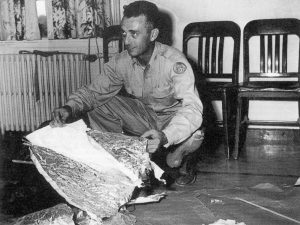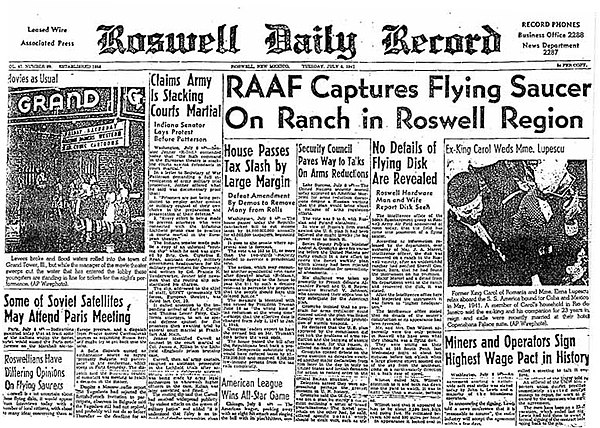By A. E. King
In the summer of 1947, supernatural fame struck a small southwestern town in the United States overnight. A collection of mysterious rubble found and collected by local rancher Mac Brazel, changed the course of Roswell’s history, linking the small New Mexico town to UFOs and alien activity for decades to come.
On July 4th, Brazel discovered and collected strange materials found on Foster Ranch, bringing them to local sheriff George Wilcox. Wilcox contacted the nearby army airfield base. Eventually Major Jesse Marcel went to the crash site to investigate. On the morning of July 8, the public information offices of the airfield base issued a press release claiming to have found a flying saucer. Local papers ran the story that morning, frantically writing “[Roswell Army Air Field] Captures Flying Saucer On Ranch in Roswell Region.” Immediately after the release of the story, however, the Air Force retracted their previous account and instead identified the debris as pieces of a weather balloon. The next day on July 9, local papers reported the new explanation. Afterward, the world allowed the Roswell incident to fade quickly from memory.

Major Jesse Marcel from the Roswell Army Air Field photographed with debris.
But in 1978, the world promptly remembered. Stanton Friedman, a nuclear physicist, and UFO researcher interviewed Major Jesse Marcel, who claimed he still disagreed with the official explanation and decided the material was certainly not from a weather balloon. Friedman publicly called the Roswell incident a massive cover-up. This accusation reignited the nation’s interest in the Roswell incident and jump-started a conspiracy theory about the U.S. government.
The Roswell incident is interesting to note in the larger scheme of American conspiracy and fake news, especially for how it represents the growing pressure of social and political environments at the time. Changes in the American government was one key factor. Before World War II, the American government had been weak and inefficient. For most of its history, America preferred an isolationist approach to foreign policy. In doing so the United States lacked the necessary influence and experience to exert its power on opposing groups. World War II and the Cold War brought a drastic change.
In the devastating aftermath of World War II, the American government set itself on the fast-track to becoming a global superpower. The paranoid rivalry of the Cold War strengthened the U.S. government, making it more secretive and meddlesome. Misdirection, dissuasion, and obviation all became highly effective approaches to government, and by the 70’s this tactic was commonly implemented in maintaining national secrecy. While effective against enemies, this also opened up an exploitable loophole in American trust, creating a space for conspiracy theorizing.
America in the late 1940s was in a state of hypervigilance. The uncertainty of the future lent itself well to a simple fear in the minds of the American people. A fear of the unknown, such as the rapidly developing technologies, shifting alliances, and rumored undercover spies were all very real and pressing issues to many. The American government helped to sell this narrative with fear and paranoia. Unfortunately, paranoia can always spiral out of control, and the risk of maintaining power through misdirection is having it turned inward. The “red scare” of the 1950s is an example of this, as cultural anxiety overloaded onto itself to create a period of hyper-suspicion.
The Roswell incident was much the same. As the story picked up interest again during the late 1970s, societal tensions were running high. The Vietnam war, the iron curtain, and conflict in the Middle East all pressured the American government and public, and fear of mysterious threats and anxieties quickly turned to paranoia at other unexplained secrets. Conspiracy theories flourished in this environment, directing pent-up tensions at the increasingly large, powerful, and mysterious U.S. government. The conspiracy theory about the Roswell incident was an accumulation of this fear, where the unknown had pushed people to become weary and hyperaware.
Roswell worked on two levels. First, in how it interpreted mistrust and misinformation both inside and outside the government. The unwelcomed intervention of the government in foreign affairs at the time (such as in Vietnam) had already aroused suspicions. Combined with the increasingly complex chain of command throughout the story, as well as the contradictory press releases considering the debris, it was almost to be expected that people would become suspicious.
Secondly, the Roswell conspiracy worked due to the fear of the greatest unknown: space. In a galaxy of time and energy, it is hard to ignore the possibilities of extraterrestrial life. Alien conspiracies persist then because of how hard it is to prove that something might not exist in the expansive infinity of time and space. Additionally, the resurgence of the Roswell theory set it after the space race, a time when American society was looking up at the stars and searching for answers.
In Witness to Roswell: Unmasking the 60-year cover-up, Thomas J. Carey and Donald R. Schmitt interviewed key military and civilian witnesses for their testimony on the crash site and subsequent handling of the findings. Most of these interviews included memories of alien bodies found in the debris. According to eye-witness testimonies, the bodies were between three-and-a-half to four feet tall. They had large, triangular skulls, with large eyes and small, slit mouths. On the night of the crash, a local military hospital received childlike bodies, with several people reporting the otherworldly horror of both their appearances and the resulting rush to preserve them.
Although the military later denied any association with these claims and debunked them thoroughly, the persistence of these images concerning Roswell firmly establish the role of extraterrestrial fear in Roswell’s conspiracy.
Today Roswell, New Mexico, still thrives off of the Roswell conspiracy. The town features the title, “UFO capital of the world,” while it maintains both the International UFO Museum & Research Center and the UFO Museum’s Research Center Library, and holds an annual Rowell UFO festival. To this small southwestern town, the truth of that night in 1947 is almost inconsequential. The community’s tourism industry thrives off of the Roswell conspiracy, and after the national coverage received over years of speculation, Roswell has secured its destiny as the home of Alien infamy. “The truth” may or may not be out there, but the profit certainly is.
